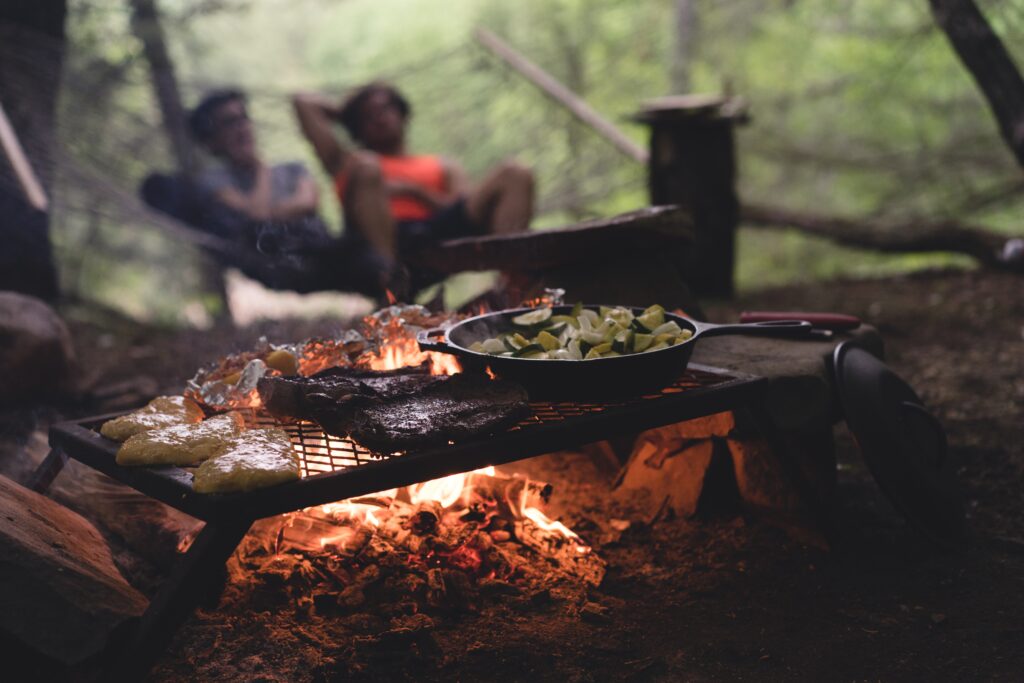Mastering the Art of Campfire Cooking
District Executive Chef John Horne shares his tips and tricks for cooking in the great outdoors
Whether you’re a seasoned camper or fresh-faced adventurer, there’s nothing quite like the joy of crafting a delicious meal over a crackling campfire. To help you tackle the world of open-flame cooking and turn your wilderness meals into unforgettable dining experiences, we tapped our own culinary leader and lifelong outdoorsman District Executive Chef John Horne to share his expertise.
From ensuring you have the right tools to positioning your pit for optimal results, he’s dishing out his tried-and-true tips guaranteed to make any camping trip a gastronomic triumph. So gather ’round the virtual campfire as we explore the art of cooking in the great outdoors. Let’s dig in!

Keep a Stash
If you don’t plan on bringing your own firewood, knowing what you can use from the forest is a big help. Chef Horne likes to source white birch bark, as it acts like newspaper and is easy to carry if you find it on your hike. “Using dead branches on the bottom half of an evergreen tree will light, wet or dry, and the sap helps to get the fire going as well,” he says. “Driftwood, dry moss, and grass will also help to get a fire going.” Make sure to collect wood frequently, as beyond meals, a good stash will mean the difference between a cold evening and toasty toes.
Have a Stable Setup
A good campfire cooking experience starts with the right setup. Refrain from cooking on uneven ground or anywhere that makes it difficult to set up your pots or pans. Before you get lighting, find a patch of even land with rocks around it or somewhere you can easily dig a pit (hot tip: pack a retractable camping shovel). “Containing the fire, so heat is concentrated up, will give you a better heat source,” Horne says. “It also acts as a stable base for a grill, rack, or cast iron pan.” There’s nothing worse than having your pot of water tip over and put out your flames or — even worse — tripping on the uneven ground by the fire.
Hot Coals Are Your Friend
Big, fiery flames are not always the goal. In fact, they can make it easy to burn your dinner before it’s even half-cooked. If using a pit, light your fire early with lots of wood and let it burn down to a bed of coals (hardwood is the best for this) before you start cooking. “Sometimes I like to build two fires,” says Horne. “One to create hot coals and another to cook on. By feeding the cooking fire hot coals, it keeps the temperature up and the flames down.”
Wrap Your Food
Wrapping or layering your food will help control how much heat is let in, allowing for less burning and a more even cook. Tinfoil works well, but you can also use what’s lying around (bonus: if you go this route, you don’t have to carry old foil back home). Seaweed or freshwater weeds work well, but you can also use cattail reeds, ferns, moss, or wet wood like cedar. Throw a layer on the coals and place your food on top or double up to create a steaming effect. “My favourite thing to do is soak corn in its husk and throw it straight on the coals,” says Horne. When you’re ready to eat, peel back the husk to reveal amazing steamed and roasted corn!”

Rock ’n Roll
A thin, flat rock can offer a great base for your pots and pans. If you’re wrapping your food, place hot rocks from the fire on top to speed up the cooking process. “I have even thrown hot rocks from the fire into my pot of water to help bring it to a boil faster,” Horne advises. On the topic of pans, it’s hard to beat a good cast iron, but aluminum pots are nice and light and transfer heat quickly.
Cooked to Imperfection
Cooking over a fire is never easy, as the heat source is hard to control compared to your home kitchen’s stove. “Finding that sweet spot can be difficult, and you’ll find that it may only last five minutes before you have to readjust,” says Horne. “Be prepared for some burnt ends or even a little bit of charcoal on your food. It all adds flavour!”
Leave Your Site Better Than You Found It
“As an outdoorsman, there’s nothing more heartbreaking than coming across someone else’s trash in the woods,” says Horne. Before you leave your site, take an extra few minutes to make sure you haven’t left anything behind. This includes ensuring your fire is completely out — including hot coals. “Coals can smoulder in the ground for days on end and can even reignite depending on the conditions. To avoid causing a forest fire, triple-check to ensure everything is safely extinguished.”
There you have it! As the sun sets on our campfire culinary adventure, remember that with the right guidance, an open flame can be your best sous chef. So go on, let the flames dance and the aromas swirl — and may your next camping journey be one filled with impeccable views, starry skies, and delectable delights.
Happy cooking, adventurers!

